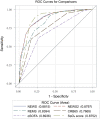Evaluation of the Risk Prediction Tools for Patients With Coronavirus Disease 2019 in Wuhan, China: A Single-Centered, Retrospective, Observational Study
- PMID: 32897668
- PMCID: PMC7448719
- DOI: 10.1097/CCM.0000000000004549
Evaluation of the Risk Prediction Tools for Patients With Coronavirus Disease 2019 in Wuhan, China: A Single-Centered, Retrospective, Observational Study
Abstract
Objectives: To evaluate and compare the efficacy of National Early Warning Score, National Early Warning Score 2, Rapid Emergency Medicine Score, Confusion, Respiratory rate, Blood pressure, Age 65 score, and quick Sepsis-related Organ Failure Assessment on predicting in-hospital death in patients with coronavirus disease 2019.
Design: A retrospective, observational study.
Setting: Single center, West Campus of Wuhan Union hospital-a temporary center to manage critically ill patients with coronavirus disease 2019.
Patients: A total of 673 consecutive adult patients with coronavirus disease 2019 between January 30, 2020, and March 14, 2020.
Interventions: None.
Measurements and main results: Data on demography, comorbidities, vital signs, mental status, oxygen saturation, and use of supplemental oxygen at admission to the ward were collected from medical records and used to score National Early Warning Score, National Early Warning Score 2, Rapid Emergency Medicine Score, Confusion, Respiratory rate, Blood pressure, Age 65 score, and quick Sepsis-related Organ Failure Assessment. Total number of patients was 673 (51% male) and median (interquartile range) age was 61 years (50-69 yr). One-hundred twenty-one patients died (18%). For predicting in-hospital death, the area under the receiver operating characteristics (95% CI) for National Early Warning Score, National Early Warning Score 2, Rapid Emergency Medicine Score, Confusion, Respiratory rate, Blood pressure, Age 65 score, and quick Sepsis-related Organ Failure Assessment were 0.882 (0.847-0.916), 0.880 (0.845-0.914), 0.839 (0.800-0.879), 0.766 (0.718-0.814), and 0.694 (0.641-0.746), respectively. Among the parameters of National Early Warning Score, the oxygen saturation score was found to be the most significant predictor of in-hospital death. The area under the receiver operating characteristic (95% CI) for oxygen saturation score was 0.875 (0.834-0.916).
Conclusions: In this single-center study, the discrimination of National Early Warning Score/National Early Warning Score 2 for predicting mortality in patients with coronavirus disease 2019 admitted to the ward was found to be superior to Rapid Emergency Medicine Score, Confusion, Respiratory rate, Blood pressure, Age 65 score, and quick Sepsis-related Organ Failure Assessment. Peripheral oxygen saturation could independently predict in-hospital death in these patients. Further validation of our finding in multiple settings is needed to determine its applicability for coronavirus disease 2019.
Conflict of interest statement
The authors have disclosed that they do not have any potential conflicts of interest.
Figures

Comment in
-
Coronavirus Disease 2019 Prediction Modeling: Everything Old Is NEWS Again.Crit Care Med. 2020 Nov;48(11):1702-1703. doi: 10.1097/CCM.0000000000004630. Crit Care Med. 2020. PMID: 32932350 No abstract available.
References
-
- World Health Organization: Novel Coronavirus (COVID-19) Situation Report-149. 2020. Available at: https://www.who.int/docs/default-source/coronaviruse/situation-reports/2.... Accessed June 17, 2020
-
- Wu Z, McGoogan JM. Characteristics of and important lessons from the coronavirus disease 2019 (COVID-19) outbreak in China: Summary of a report of 72314 cases from the Chinese Center for Disease Control and Prevention. JAMA 2020; 323:1239–1242 - PubMed
Publication types
MeSH terms
LinkOut - more resources
Full Text Sources

